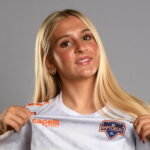Separating fitness and skill (part 1 of 2)
By Jennifer Schwartz
Editor’s note: Jennifer Schwartz is the owner of Impact Fitness DC, a professional private training company providing fitness services to female athletes, teams, individuals, and small groups in Washington, D.C. She holds a certified mastery in biomechanics with a specialization in resistance training and muscle activation techniques™, and is also a United States Soccer Federation-licensed coach with the Alexandria Soccer Association. Soccer Wire is very pleased to present Jennifer’s perspectives on biomechanics and injury prevention.
Chances are you have seen sports performance training making an appearance in your local soccer club.
Traditionally, it was the coach’s responsibility to both physically develop and condition the athlete to curb injuries. In an effort to move away from this “all-encompassing” mind set, U.S. soccer programs are beginning to gear their programs to mirror the European “academy teaching” styles.
In a country that doesn’t have the same historical love affair with “the beautiful game” — where you are more likely to find a basketball court on the streets versus a soccer pitch — you are beginning to see top coaches working with younger players to make sure development actually occurs.
To both coaches and parents, I need to say this loud and clear: physical development has to happen outside of skill/technical development to allow U.S. soccer to grow to its potential. There is a time and a place for both in creating a well-rounded, injury-free athlete. The best things for our athletes, and the US game, are higher standards in education along with fine-tuned execution in teaching the essential elements of the game, combined with fine-tuned execution in teaching strength training.
A well-developed team can reach high levels of competition, but it’s whether or not they stay there to earn scholarships and national recognition that becomes the effort of a sport performance professional to maintain. The recent trend is to hire a trainer to run a team through agility ladders and plyometric training. This can be challenging for a player technically and for their joint mechanics. If a player can’t pass, receive or move the ball well, a trainer with agility ladders won’t make them a better player; they cannot hide behind speed if they are going to reach a high level.
The issue of joint mechanics is a complex one that will not receive the in-depth explanation I can give it in this piece. Both industries, U.S. soccer coaches and sports performance professionals, have had the practices of bygone eras. In the coaching world we have had generations of highly notable coaches in the upper age ranges ( Under-16/18) while virtually ignoring the youth players who need to develop skills and competency with both feet.
In the world of fitness and sports performance, I witness hundreds of people calling themselves professionals or experts while their education is that of a fitness consumer. These so called “professionals” define their expertise by applying an exercise program designed for an elite MLS athlete to an adolescent with the intent to prevent injury.
This is an example of true fitness malpractice. There needs to be a shift in philosophies, where the modern coach values developing their players more than anything else, rather than winning a U-12 tournament — being a fitness educator, not a consumer with a list of exercises.
I am bound and determined to “walk the walk.” The teams and individual athletes I coach experience success as a result of my constant dedication to understand each and every variable in producing and improving strength. The same way you want a dentist with perfect teeth and gums, you need a coach affluent enough to understand a match at any age level.
The best coaching professionals know the role of every jersey on a squad, how each individual learns, the importance of embracing each player’s unique personality, bringing emotion and intricacies of formation into each training session. They go through self-editing and continuing education with consistent, logical training goals; interpreting the technical aspects through awareness of each athlete’s tactical approach.
The best performance professionals do not operate with a list of exercises. The best professionals work with the science behind exercise, physics, and understand the body’s capacity to respond to demand. The end result of working with a trainer who has a list of exercises in their hand will get you a long list of overuse injuries and unanswered questions.
The end result of working with uneducated coaches that know more about basketball than soccer has caused a ‘win at all costs’ multi- generational attitude and little success on the national and international stage. North American soccer has been working diligently to weave the importance of player development into our soccer culture. In order to do so, we have to commit to physical training outside of soccer training sessions.
I implement three key aspects into the clubs and teams I work with — strength training, athlete regeneration, and comprehensive education. Age-appropriate strength training is critical for an athlete to compete optimally with academy training volume and intensity. An effective athlete has to have a solid base of strength, which isn’t attained solely through body weight exercises in much of popular protocol.
Strength training has to be strategic to be effective and strategy is achieved by manipulating the resistance used in the training, which cannot be achieved without equipment. The modern athlete has numerous new stressors in their life, that we even a generation ago did not have. Strength training can be a favorable tool to bring a balance to the challenges of the modern athlete. An athlete’s body is their tool for competition.
Ask any professional — regeneration (silent training) is very important in creating overall fitness. Adequate sleep, proper nutrition and stress reduction are some of the most basic forms of regeneration; but coupled with more complicated elements and overall body awareness, the athlete will have an arsenal of tools to compete most effectively on their own or with a team. A working knowledge of what is age-appropriate and the best intentions for each athlete create a comprehensive knowledge of how to maintain peak fitness and performance.
For both soccer training and performance training, all of the fantastic tools and complicated variables used to improve our game have to be utilized with detail and repetition. After all, it is not just access to these tools, but how we use them, that make us great!
SOCCERWIRE MARKETPLACE
- The St. James FC Travel Staff Coach - North (Loudoun) & South (Fairfax)
- The St. James FC Girls Academy (GA) Head Coach - 2 teams
- The St James FC Boys Travel Tryouts
- OFFICIAL BAYERN MUNICH SUMMER CAMPS U.S.
- JOIN THE ALLIANCE!
- OFFICIAL FC BARCELONA CAMPS U.S.
- The Cup San Diego - Hosted by Legends FC
- Players Wanted - Undergraduate or Post-graduate
- Head Coach - South Region at The St. James FC
- Travel Coach - North Region at The St. James FC











